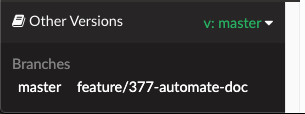Contributing to E3SM Diags¶
Code¶
We would welcome you feedback and suggestions on how to improve E3SM Diags. Drop a line to Jill (zhang40 .at. llnl.gov) or Ryan (forsyth2 .at. llnl.gov).
Or would you like to directly modify E3SM Diags? We tried to build the code in such a way to make it easy to modify and add new backends, diagnostics, plots, variables, etc. We would welcome your contributions. Create a development environment and start coding away. Then submit your suggested modifications via a pull request.
Documentation¶
Something incorrect? Something missing? Want to add some cool examples? We would welcome your help updating and maintaining this documentation. Here is a quick guide on how to get started doing just that.
Getting Started¶
This documentation is created using Sphinx. Sphinx is an open-source tool that makes it easy to create intelligent and beautiful documentation, written by Georg Brandl and licensed under the BSD license.
The documentation is maintained in the master branch of the GitHub repository.
You can include code and its corresponding documentation updates in a single pull request (PR).
After merging a PR, GitHub Actions automates the documentation building process.
It pushes the HTML build to the gh-pages branch, which is hosted on GitHub Pages.
Edit Documentation¶
Sphinx uses reStructuredText as its markup language. For more information on how to write documentation using Sphinx, you can refer to
To begin editing:
Set up your local development environment if you haven’t already.
To modify the documentation, simply edit the files under
docs/source.To see the changes you made to the documentation, rebuild the web pages
cd <myDir>/e3sm_diags conda activate e3sm_diags_env_dev cd docs python source/quickguides/generate_quick_guides.py # Run if quick-guide files were updated make html # no version selector dropdown will be generated
View them locally in a web browser at
file:///<myDir>/e3sm_diags/docs/_build/html/index.html.Once you are satisfied with your modifications, commit and push changes to the repository:
cd <myDir>/e3sm_diags # `docs/_build` is ignored by git since it does not need to be pushed git add . git commit "..." git push <fork-origin> <branch-name>
<OPTIONAL> If you want to generate and view versioned docs:
# After commiting to your branch cd docs sphinx-multiversion source _build/html # Check the `_build/html` folder for all generated versioned docs # Open `_build/html/<your-branch>/index.html` to view in browser

Docs version selector dropdown in the bottom left-hand corner¶
Create a pull request from
<your-fork>/e3sm_diags/branch-nametoE3SM-Project/e3sm_diags/master.
Once this pull request is merged and GitHub Actions finishes building the docs, changes will be available on the e3sm_diags documentation page.
How Documentation is Versioned¶
The sphinx-multiversion package manages documentation versioning.
sphinx-multiversion is configured to generate versioned docs for available tags and
branches on local, origin (the likely name for your <fork-origin>) and
upstream (the likely name for your <upstream-origin>).
Branches or tags that don’t contain both the sphinx source directory and the conf.py file will be skipped automatically.
Skipped versions include releases
< v2.5.0since the documention source was not included in those tagged releases.Run
sphinx-multiversion source _build/html --dump-metadatato see which tags/branches matched.
Converting Jupyter Notebooks¶
If you have Jupyter notebooks that you’d like to import into the documentation, they can easily be converted to rst format:
$ jupyter nbconvert mygreatnotebook.ipynb --to rst
Initial setup (obsolete/for reference only)¶
The instructions below only apply for the initial configuration of the Sphinx documentation on the Github repository. They are documented here for reference only. Do not follow them unless you are setting up documentation for a new repository. (Adapted from Sphinx documentation on GitHub.)
Create Sphinx conda environment (see above).
Create a new git branch (gh-pages):
$ git branch gh-pages
$ git checkout gh-pages
Clear out anything from the master branch and start fresh
$ git symbolic-ref HEAD refs/heads/gh-pages
$ rm .git/index
$ git clean -fdx
Create documentation
$ sphinx-quickstart
accept suggested default options, except
Separate source and build directories (y/N) [n]: y
Edit Makefile and change BUILDIR
BUILDDIR = docs
Remove old build directory
$ rmdir build
Change the Sphinx theme to ‘ReadTheDocs’. Edit ‘source/conf.py and change
html_theme = 'alabaster'
to
import sphinx_rtd_theme
html_theme = "sphinx_rtd_theme"
html_theme_path = [sphinx_rtd_theme.get_html_theme_path()]
Try building documentation
$ make html
Create an empty .nojekyll file to indicate to Github.com that this is not a Jekyll static website:
$ touch .nojekyll
Create a top-level re-direction file:
$ vi index.html
with the following:
<meta http-equiv="refresh" content="0; url=./docs/html/index.html" />
Commit and push back to Github:
$ git add .
$ git commit
$ git push origin gh-pages